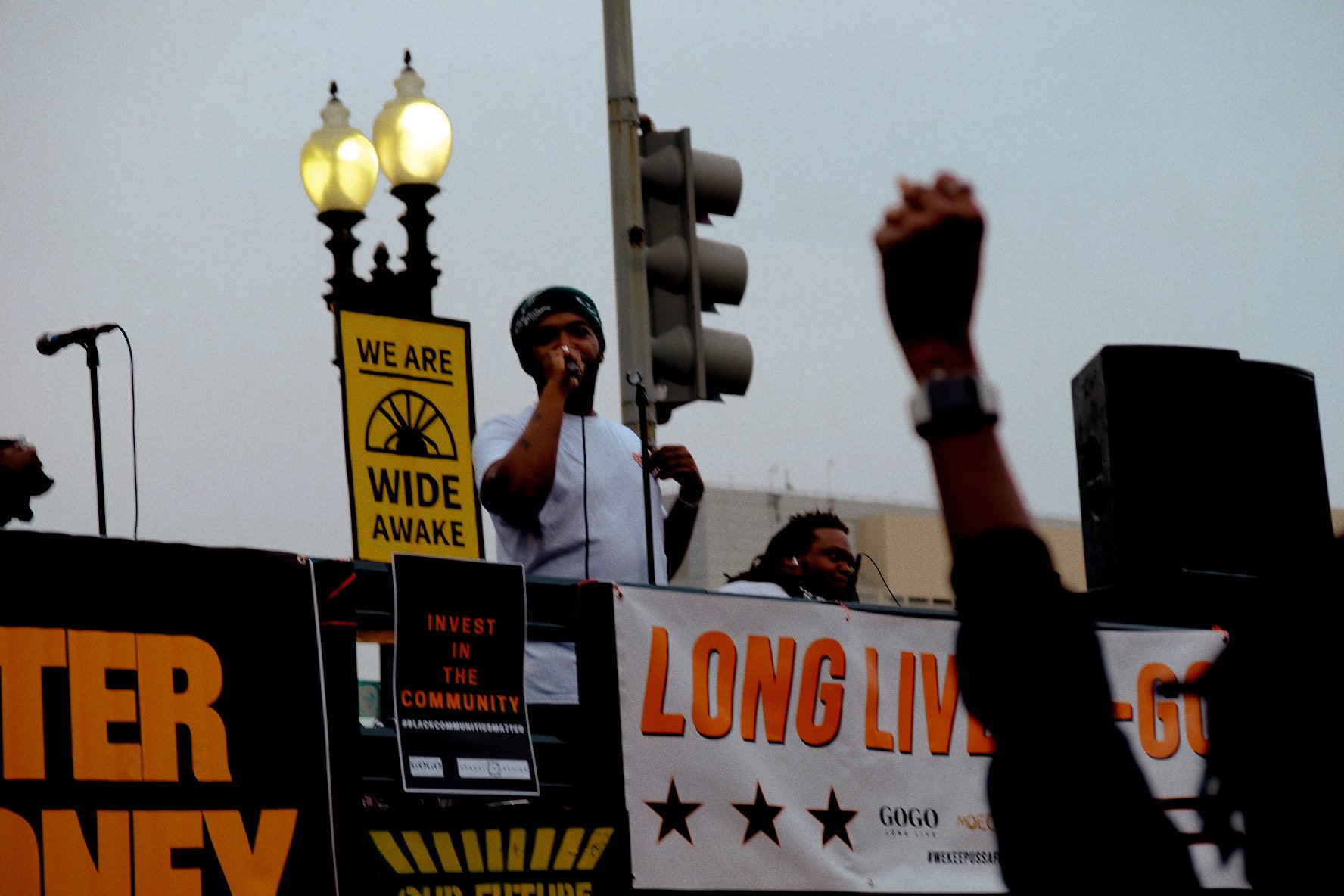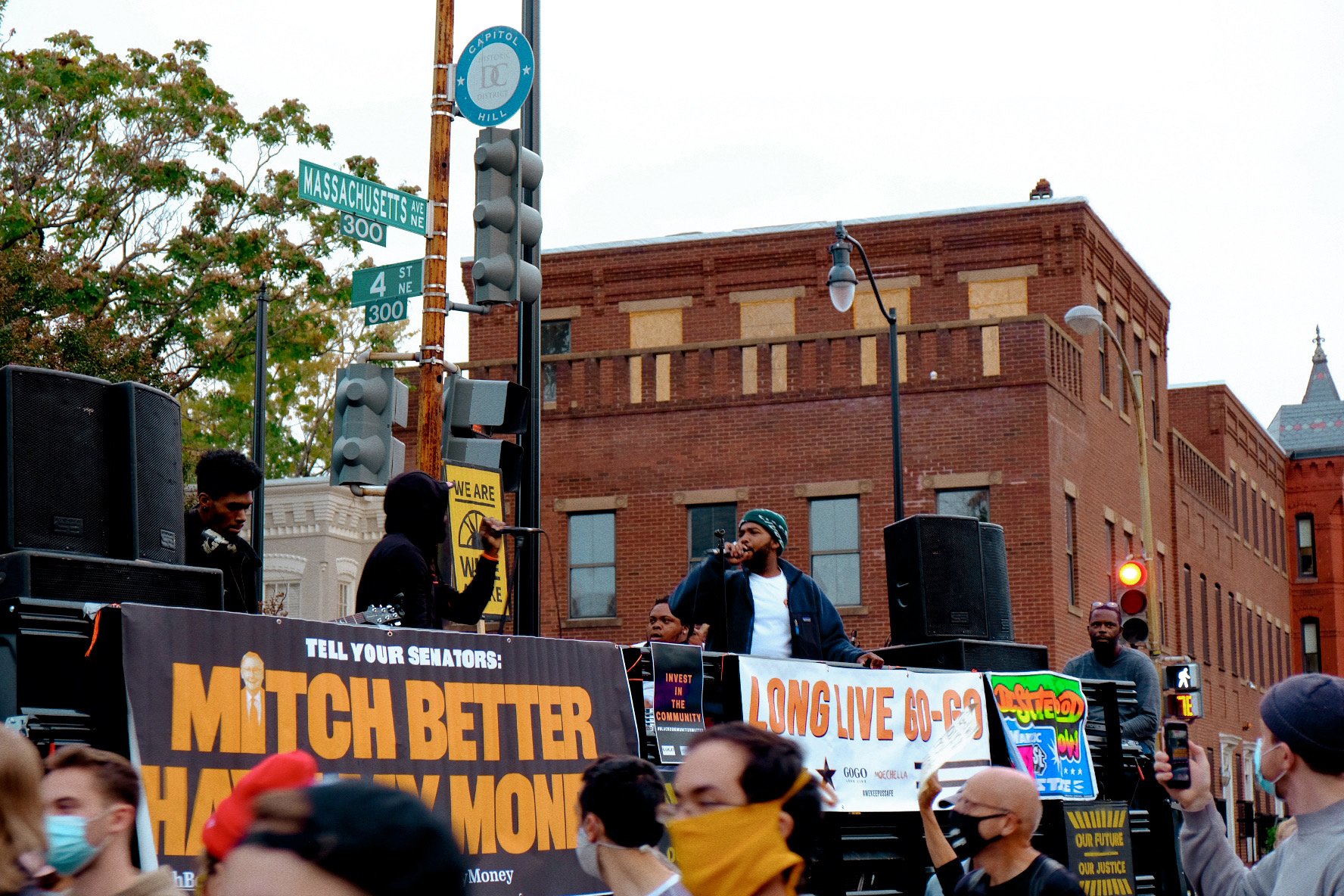Go-Go Is Bringing Equity to the DMV
Note: This article was published in our OCT 2020 Issue on October 31, 2020.
Over the years, we have seen go-go music repeatedly applied as a useful and indeed effective organizing tool for activists and community leaders in D.C. This summer, as tens of thousands of protesters filled the streets of D.C. in support of the Black Lives Matter movement, go-go music was often the soundtrack. On the night of Trump's RNC 2020 nomination acceptance speech, thousands of D.C. residents gathered as close to the White House as police would let them. The mission was to drown out the president's speech, and once again, the music was the weapon. On September 26th, a coalition of DC-based activist organizations including the Sunrise Movement, the Palm Collective, and Shutdown DC teamed up with Long Live Go-Go for an early morning noise demonstration in front of Senate Majority Leader Mitch McConnell’s home.
The truth is, go-go music is crucial to seeing equity in DMV; here's why.
Go-Go is the lifeblood of D.C.
Go-Go is a fusion of musical forms, drawing its style from funk, blues, soul, and salsa. Go-Go music originated in the District of Columbia in the 1970s at a time when the city was majority Black, thus earning the city’s non-federal areas the name “Chocolate City.” The music remains very popular and has seen a revival recently in the Washington Metropolitan Area, a.k.a. the DMV, due to advocacy efforts and recent racial injustices. Early pioneers of the style include the crowned “emperors of go-go” Young Senators, Black Heat, and the now legendary singer-guitarist Chuck Brown.
American guitarist and “father of go-go” Chuck Brown.
Through conga-driven syncopated polyrhythms, known as the pocket beat, multiple percussion instruments, and the culture of call-and-response that turns the crowd into part of the show, go-go achieves a seamless blend of crafted sound unique only to the DMV and rivaling that of other home-grown music destinations such as New Orleans, Chicago, Austin, and Nashville. Go-Go renditions of popular songs like Ashlee Simpson’s “Pieces of Me” and Adele’s “Hello” can get more popular than the actual song, at least in the DMV.
Go-go came under attack
Go-Go has endured decades of cultural shifts, fluctuations in popularity, the crack epidemic, law enforcement crackdowns, and gentrification. The music form has been historically criminalized by the District of Columbia. It was often scapegoated for the crimes that occurred during the height of the crack epidemic and ensuing drug-related violence that named D.C. the “murder capital of the nation” for years. This led to heavy policing of go-go, a false public image of go-go as “ghetto”, and an unexamined association with criminal activity that lasted for decades.
Around 1984, crack cocaine was introduced to Washington D.C. What followed was a drug epidemic that brought havoc to D.C. The drug took hold in both Black and white areas of D.C. and Maryland, but it was Black people who were especially ravaged and demonized. Crack turned go-go shows into magnets for violence. Authorities blamed the music and live performances for fostering violence which led to heavy policing of go-go venues and businesses that supported go-go. However, go-go artists and activists say go-go was simply the soundtrack to a city in crisis.
In the late 1980s, in response to the social climate, D.C. lawmakers instituted strict curfew laws that targeted young black Washingtonians who attended go-go venues. On the other hand, the curfew excluded movie theaters and venues for European performance art. According to the Washington City Paper, the Metropolitan Police Department kept a secret weekly internal “go-go report” tracking all planned concerts in the area. From the 1980s to the 2000s, the Liquor Board and Alcohol Beverage Control Board targeted businesses that supported go-go by issuing violations and revoking licenses. This effort to criminalize go-go and the community had long-lasting, damaging effects on the image of go-go and the lives of many Black Washingtonians.
Washington D.C. has been described as “ground-zero” for gentrification in the U.S. While it no longer ranks first in the nation as the most intensely gentrified city, D.C. held that rank from 2000-2013 (it currently ranks No. 13). The displacement of majority-Black residents by majority-white newcomers is still a major ongoing issue. D.C. presents the starkest examples of displacement in the country. On April 8th, 2019, in a now well-known tale of gentrification in D.C., a resident of a new luxury condo in Shaw threatened to sue a Metro PCS store owned by Donald Campbell after complaining about the go-go music that emanated loudly from the store daily. Campbell was told to turn off the music he’d been playing through sidewalk speakers for over 20 years. In a swift response, the silencing sparked a series of go-go-themed demonstrations for weeks, a petition which gained 80,284 signatures, and #DontMuteDC went viral gaining the attention of millions globally.
Go-Go is a unifier
Music plays a crucial role in bringing humans together. Go-Go is no exception. Go-Go rallies peacefully assemble all walks of life in the District. On May 8th, 2019, nearly 3,000 people took to D.C.’s 14th and U Street for a go-go concert as part of Moechella and supporting #DontMuteDC. The peaceful assembly gathered old and young community members, artists and performers, religious and political leaders, and even Native Washingtonians and gentrifiers themselves. Moechella and the Million Moe March takes the DMV slang “moe” (an exclamation or a slang term for a friend or person) and turns it into a grassroots effort to promote go-go gatherings, organize against systemic injustices, and resist the gentrifying forces of wealthy, often white, inhabiters of D.C. who seek to silence the deeply rooted culture of go-go.
#DontMuteDC rallies inspired rallies in New Orleans after a black brass player, Eugene Grant, was arrested following a noise complaint about his jazz band in an area where many of the city’s jazz clubs exist. The rally, dubbed #DontMuteNOLA, rallied together the brass band community and led to Grant’s charges being dropped. Organizers in D.C. and NOLA later joined forces for a “DontMuteDC meets DontMuteNOLA” battle of the bands between go-go and brass band performers.
Go-Go rallies are effective
Go-Go rallies helped Donald Campbell turn his music back on; aided in staving off Southeast’s United Medical Center from devastating budget cuts; swayed the District to grant a $152M expansion project for Black and low-income-serving Banneker High School; and compelled the DC Council to designate go-go as the official music of the District this past February.
Go-Go rallies are loud, fun, and an effective way to bring people out in support of a cause in the DMV. Since they are a form of protest, no permit is needed. The music can energize the crowd, ranging from festive, to solemn, to uplifting. D.C. politicians, who often rediscover their affection for go-go during election season, understand go-go’s influence and often organize go-go-themed campaign rallies for this reason.
Go-Go is part of a larger struggle
Go-Go’s official recognition as “the official music of D.C.” in 2020 has everything to do with how the D.C. council and newcomers tried to criminalize and displace black Washingtonians for decades. Uplifting go-go means centering the voices of the communities who’ve historically gotten the short end of the stick. It is part of a larger narrative of cultural erasure, opportunity, and reparations. Reviving go-go after the crack epidemic, after decades of criminalization, and ongoing gentrification means investing in the areas where anti-go-go policies did harm.
The effort started by #DontMuteDC against gentrification has since expanded to address other pressing issues in the city including violence, affordable housing, eviction prevention, transit equity, and increasing resources for young people, among other issues.
Go-Go is here to stay
There are many creative and reparative proposals in the works to invest in and preserve go-go. Law 23-71, the one that designates go-go music as the official music of the District of Columbia, also mandates the Mayor to implement a program to support, preserve, and archive go-go music and its history. The law not only codifies that go-go will never be muted in the district but it forces the city to pay closer attention to the inequalities among Washingtonians.
Other proposals include a go-go culture archive, a go-go museum, a mandatory go-go curriculum in public schools, a hall of fame, and go-go landmark-themed tours. One of the ways in which a streaming platform could support the adoption of go-go is by creating a company-owned playlist and hosting it on ‘browse,’ the platform’s home page. These are just some of the ideas to legitimize the cultural significance of the art form.
Crucially, equitable arts funding for go-go music in the form of a city-funded go-go cohort and public grants for go-go artists could help brand DC’s go-go scene as a tourist destination for music lovers, as Nashville, Austin, and New Orleans have done. This matters more than ever during the ongoing pandemic and federal government-driven economic crisis and is a major way for the city council to put its money where its mouth is.
The move, for the rest of us who aren’t in the DMV or within the go-go community, is to listen–– to go-go, to the marginalized voices behind the music—and to answer the call-to-action when it is presented.





